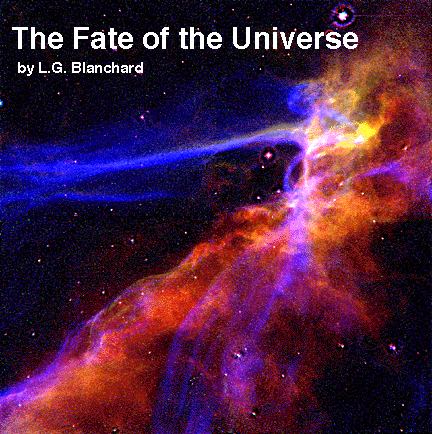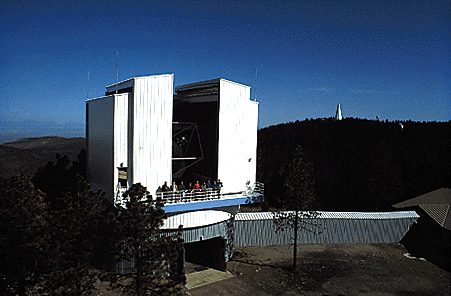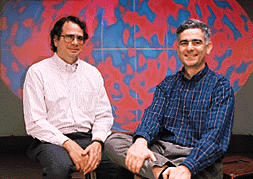

Outside, the rain pours as it has on so many other dark evenings this November--one of the Puget Sound's wettest Novembers and a perfect night for curling up with a good mystery.
But UW graduate student Brooke Patterson has another mystery to pursue, one shared this night by no one else on Earth. Despite the dense clouds overhead, she explores, in real time, a bright, terribly hot and gaseous hellhole 2.5 million light-years from Seattle.
On almost any night conditions permit, Patterson and other UW astronomy students and faculty sit in an ordinary little room in the UW's new Physics/Astronomy Building. Often with nothing more at their fingertips than a desktop computer and mouse, these intergalactic explorers are among the handful of scientists probing previously unknown mysteries of the universe at a pace unimagined even a decade ago.
In Galileo's time, cosmology--the study of the origin and fate of the universe--could be sent reeling simply by the discovery of a few moons. Today, revelations of cosmic significance appear with startling regularity thanks to new ground-based telescopes, the Hubble Space Telescope and a host of computers and other technologies in the hands of astronomers at the UW and elsewhere.
This night, Patterson's doctoral project involves exposing the mysteries hidden within galaxy M33--one of the closest galaxies to our own and among the many places within the universe, outside of Hollywood, where stars still are born. Her specific interest focuses on the nature and role of gases swirling throughout the region that, at 25,000 degrees F, are twice as hot as those on the surface of our own sun.

Painstakingly, Patterson gives intricate commands to a giant machine perched 1,200 miles away, atop a lonely, 9,200-foot peak in New Mexico: the 3.5-meter Apache Point telescope. She guides the instrument through a series of complex celestial coordinates leading like stepping stones across the heavens. At last, she pinpoints her study region and instructs the telescope to begin 15 minutes of collecting light. The light is stored on a charge-coupled device, or CCD--silicon disks, no more than a few inches in diameter, that bring the benefits of digital computer technology to modern astronomy.
Soon, another computer screen in the same room--fed by a CCD at Apache Point--becomes a modern "eyepiece" for Patterson as the actual image of her galaxy begins to appear.
With almost 100-percent efficiency--far greater than photographic plates--CCDs store even the most minute amounts of light from space, light sometimes so faint it takes a telescope hours of unblinking observation to collect it. The digital technology also enables astronomers to use computer-enhanced imaging.
When Apache Point opened in May 1994--a milestone astronomers refer to as "first light"--it became the world's first fully remote-controlled, large, ground-based telescope. It is owned and operated by the UW and the University of Chicago, along with Princeton, Johns Hopkins, New Mexico State and WSU, and students and faculty from each institution share in its use--many on the same night.
UW astronomy professor Bruce Margon, former chair of the consortium that operates the $12-million facility with support from the National Science Foundation, explains the telescope's remote-controlled advantage like this:
"At most (other) telescopes, the scheduling is one person-one night. That makes it very unlikely the instrument is being used to its best efficiency. This idea of slicing up the night into little portions represents the next step forward in using telescopes more efficiently."
In Patterson's case, the region she studies in galaxy M33 is visible from Earth only a few months a year. She will need to repeat her experimental observations again next year, explains her faculty advisor, Paul Hodge, a former department chair who watches Patterson in wonder that November night.
"It's unbelievable, the things that can be done in astronomy today compared to what we could do back then," Hodge says, referring to the birth of the UW Department of Astronomy in 1965, when he was exactly one-third of the entire astronomy faculty.
One of the greatest ironies of modern astronomy, however, is that the more scientists learn about the nature of the universe, the more they see the gaps in their knowledge. To astronomers, this can be exhilarating--to the rest of us, confusing.

Margon, for example, finds ample evidence that many members of the public have a skewed perspective on the state of modern astronomical knowledge.
"The big bang is incontrovertible, but the media keeps killing it off!" he complains, citing an example from a New York Times book review last fall. It referred to big bang cosmology--the theory that all matter in the universe came from the same single event--as "ambiguous" and "challenged by new observational data."
As Margon will tell anyone who listens, the big bang has been proven to virtually every scientist's satisfaction. "True," he cautions, lowering his voice in mock solemnity, "there never is any absolute proof.
"I mean, if you turn your back to someone, it could be that they disappear; and that each time you turn around, they pop back into being. In fact, if you turn your back on anything, it might disappear and reappear again when you turn around.
"But after a while, you just decide, `Well, it's passed every test that I can think of, so it's probably not a theory that this person or thing continues to exist whether I'm looking or not. I can't rule out positively that it's an illusion. But I'll move on to thinking about more interesting things as a more productive way to life my life.' "
But proving the big bang does not mean all is well in the state of astronomy. There are profound gaps in knowledge, for instance, about the evolving large-scale structure of the universe: how oceans of galaxies, each tiny universes unto themselves, flow, eddy, flop, bob--or do something else, entirely--within the biggest of big pictures imaginable, the cosmic macrocosm.
Perhaps the most fundamental gap of all is the missing "dark matter." When scientists add up all the atomic matter that can be accounted for under the laws of physics, there is a huge shortfall between what they know is there and what it takes to generate enough gravity to keep the heavens from flying apart. How huge? They are missing somewhere in the neighborhood of 95 percent.
Margon, who currently chairs the non-profit association responsible for operating the Hubble Space Telescope, explains the problem this way.
On the one hand, there is very strong evidence that the universe began somewhere between seven and 15 billion years ago. "Moreover, we can accurately calculate the size and density of the universe at any time over these same billions of years," he says. "And we know how every atom in the universe was made.
"Science almost certainly knows more about the first five minutes of the universe than it understands about the common cold. But we are hopelessly unsure of what the universe will look like 15 billion years from now. Most of the matter in the universe is contained in a form we have not yet discovered and that may not even consist of atoms or nuclear particles."
This mystery matter cannot be seen using any of the normal methods astronomers and physicists use. Since it literally does not radiate forms of light that can be detected by even the most sensitive of current telescopes, scientists give it the name dark matter.
A cynic might smile and say, "So what? Dark matter, large-scale structure and fate of the universe--how important is it for science to solve such puzzles?"
"There are laws of physics that can only be tested through astronomical observation, including Einstein's famous theory of general relativity, which explains how all gravity works," Margon responds.
Another reason, explains Margon, is that the big bang itself was the universe's "best and ultimate" particle accelerator. "Studying the physics of what came out of the big bang is exactly the same line of work as what high-energy physicists do when they use Earth-based atom smashers to learn more about the sub-nuclear structure of matter," he says. "The temperatures in the big bang--high temperature equating with high particle speed--were far greater than any that could ever be attained in an Earth-bound accelerator."
Astronomy's insight into fundamental laws of nature--the laws of physics--is what most interests Craig Hogan, Margon's successor as chair of astronomy and, like many of his colleagues, himself also a physicist. "Physicists have lots of experiments running in their laboratories. But we're always pushing up against the limits of what can be done," he says.
Last year, Hogan and the Lick Observatory's Michael Bolte--who received his astronomy Ph.D. from the UW in 1987--gained worldwide attention when they suggested that the oldest stars are twice as old as the universe is supposed to be in some variants of the big bang model. Hogan, however, emphasizes that there is little doubt about the most important idea of the big bang model, that the universe expanded from a very hot initial state.
"The universe is marvelous because it's this huge place with all kinds of stuff going on that's just so far beyond the power of anything we can do in a laboratory," Hogan adds.
Hodge certainly agrees. He's finding that galaxies are "very complicated, very individualistic in their development and growth." Some formed all of their stars right away, soon after the big bang. Others appear to still be forming stars, such as the Orion Nebula or M33.
Hodge believes much remains to be learned from tracking the evolutionary history of galaxies. "What we're doing is basically like archaeology: looking at the present state of nearby galaxies such as M33 and Andromeda--what a geologist would see as their surface layers," he explains.
"And then we're digging down to the galaxy's past by examining older stars and star clusters and other features that provide clues to what the galaxy was like in the past and how it formed."
The reason Hogan and others think they understand the big bang back to when it was a only few seconds old is this: There is perfect theoretical agreement between the mix of chemical elements physics predicts should have existed immediately after the big bang and the ratio that exists everywhere in the universe today.
Just like playing a movie backwards, Hogan says, "the big bang theory gets the right answer every time: it predicts that the universe today should be almost all hydrogen, and almost all the rest helium. And this apparently is true--it seems to be pervasive everywhere we look, even in the oldest stars," he says.
But what about playing the movie forwards? Christopher Stubbs, associate professor of physics and astronomy, believes settling the dark matter question will help determine the eventual fate of the universe.
"We see the universe expanding, but will the expansion continue forever?" he asks. "What will stop it? A variety of astronomical observations point to only one thing that could: gravity.
"The question is, is there enough gravitational attraction to slow the expansion--maybe even eventually bring it to a halt and turn it around and have things come back together again? We don't know whether there is enough matter in the universe to make that happen."
Right now scientists cannot detect enough matter, but that doesn't mean it's not there. "If, in fact, we're not going to be faced with an open universe that is expanding forever and ever, then there must be some exotic material that presumably arises in some part of particle physics that we just don't know about yet," says Stubbs.
There is very strong evidence, Stubbs says, that galaxies such as our own have up to 10 times as much mass as all the stars within them. One possible explanation for some of this missing matter may be more conventional than exotic: perhaps there are gaseous, Jupiter-like astronomical objects that neither emit nor absorb enough light to be seen in conventional ways.
Stubbs and colleagues at several other institutions are collaborating on a project aimed at detecting the gravitational influence of such objects on things around them as an alternative way of sensing their presence in space. So far, their search for these so-called Machos--massive compact halo objects--has yielded conflicting results.
"We did an experiment in which we would have expected to see tens of ... events if the dark matter in our galaxy was made of these Macho objects," explains Stubbs. "Instead, we saw only a few."
Does Stubbs think the missing matter issue will be resolved in his lifetime?
"I've been asking myself that a lot lately," he responds. "I think I'm fortunate to live in a remarkable time when knowledge will evolve to the point where there is a standard picture of the cosmology of the universe. The dark matter problem will be resolved, and we will have a self-consistent, coherent picture of how it all fits together.
"But at the moment, there's rampant confusion," he adds.
Despite the unsolved mysteries, Margon sees astronomy's answers benefiting humanity. "Everyone often stops and wonders, `How is my life any better than a caveman's? I still can't get along with my spouse. I still get sick. We still have wars. Has anything gotten better after 200 generations of Homo sapiens?'
"There actually are precious few things anyone can point to in terms of significant improvements. But one of them is that we are the very, very first generation of human beings to know how the universe began. And that puts us in an incredibly privileged position.
"Ever since the first caveman came out of the cave and looked up at the stars, we have asked, `Gee, I wonder how far away they are. How they got there. Who put them there. How hot they are?' And we, not our parents, but we know those answers for the first time ever." END
L.G. Blanchard writes about science for the UW Office of News and Information, where he is also assistant director.
For information about the Stardust project, the world's first sample-return mission to outer space since the Apollo moon program, try this link, Stardust Memories.
For information about how the universe is structured and the Sloan Digital Sky Survey, try this link, Lake and Sky.
Send a letter to the editor at columns@u.washington.edu.